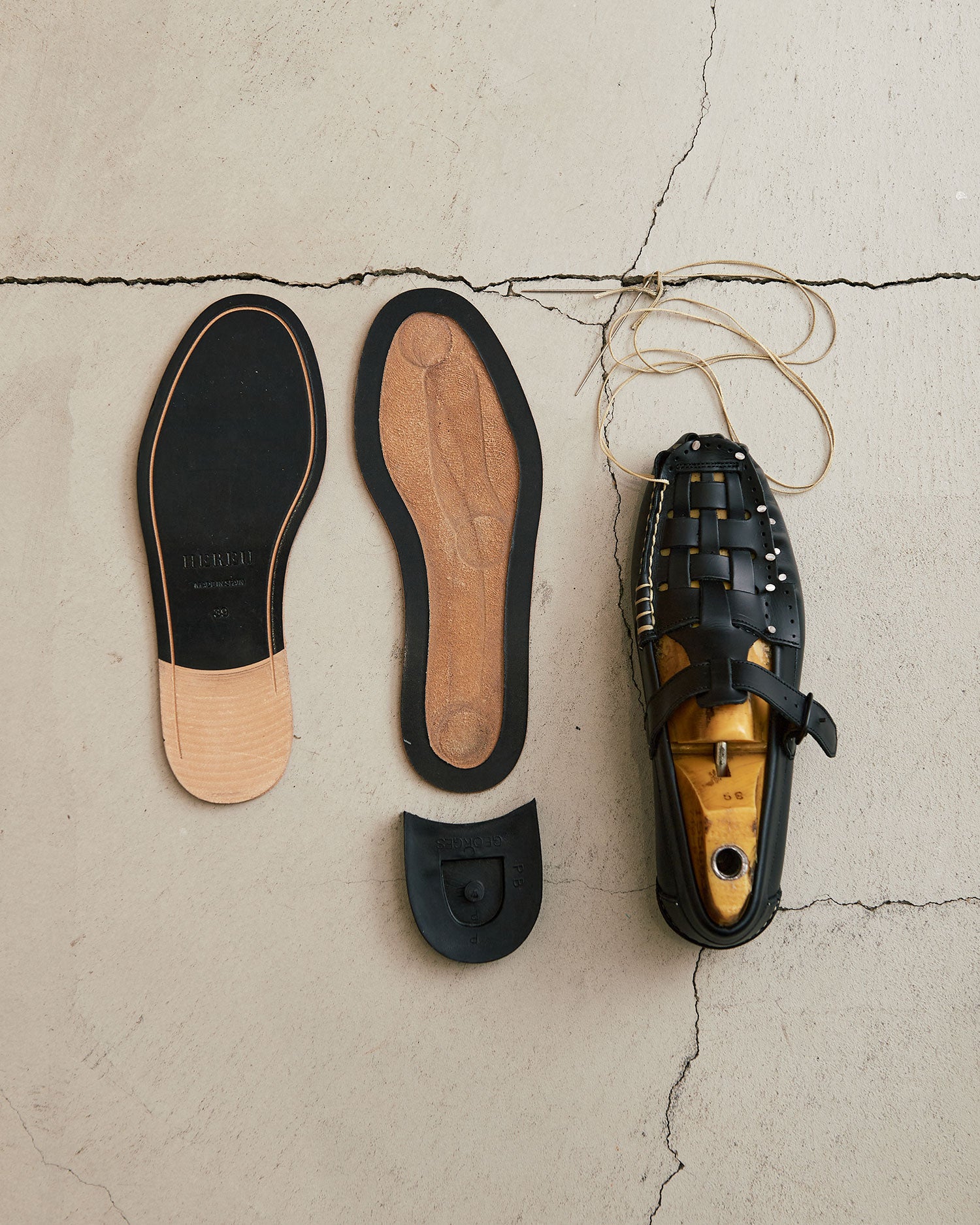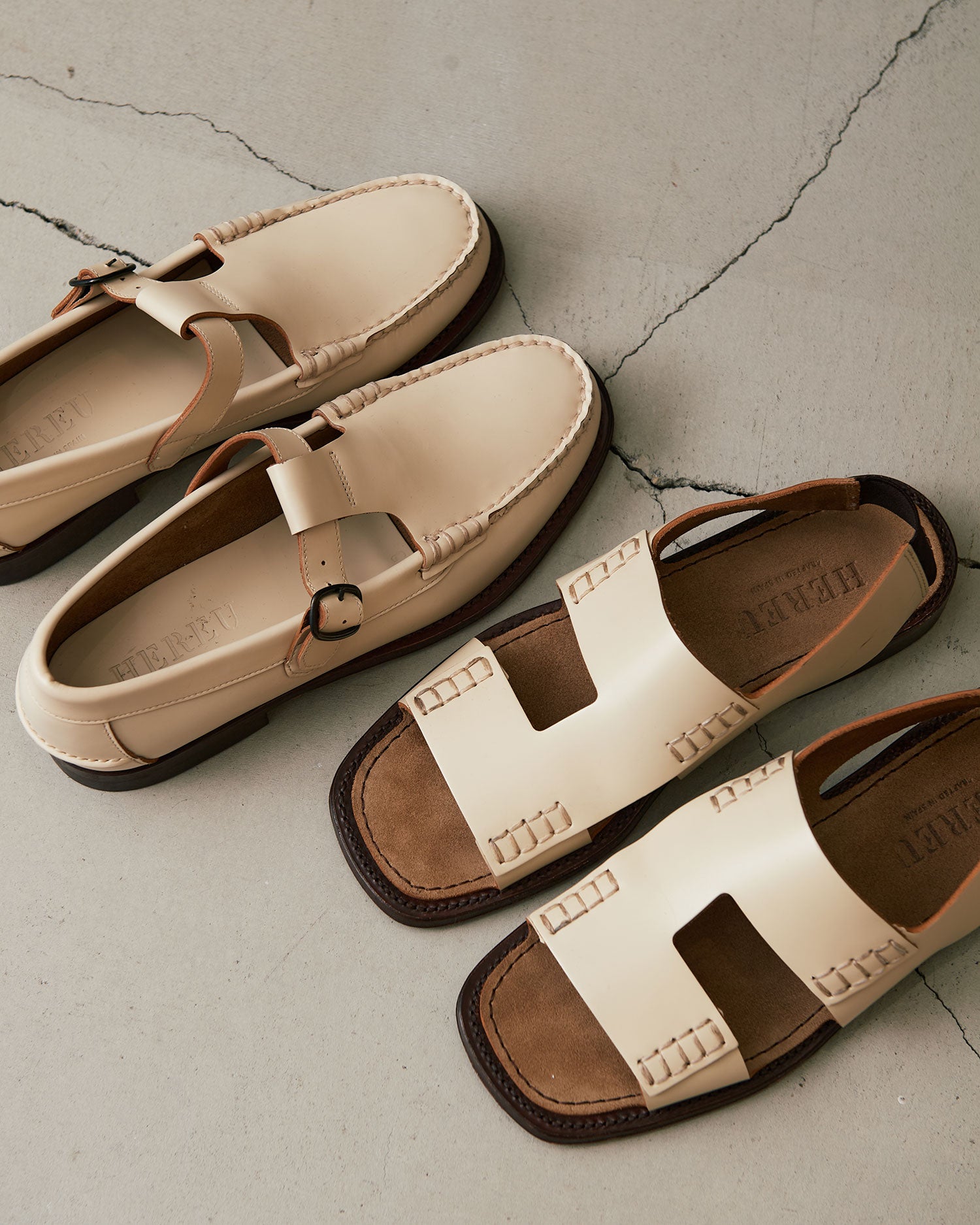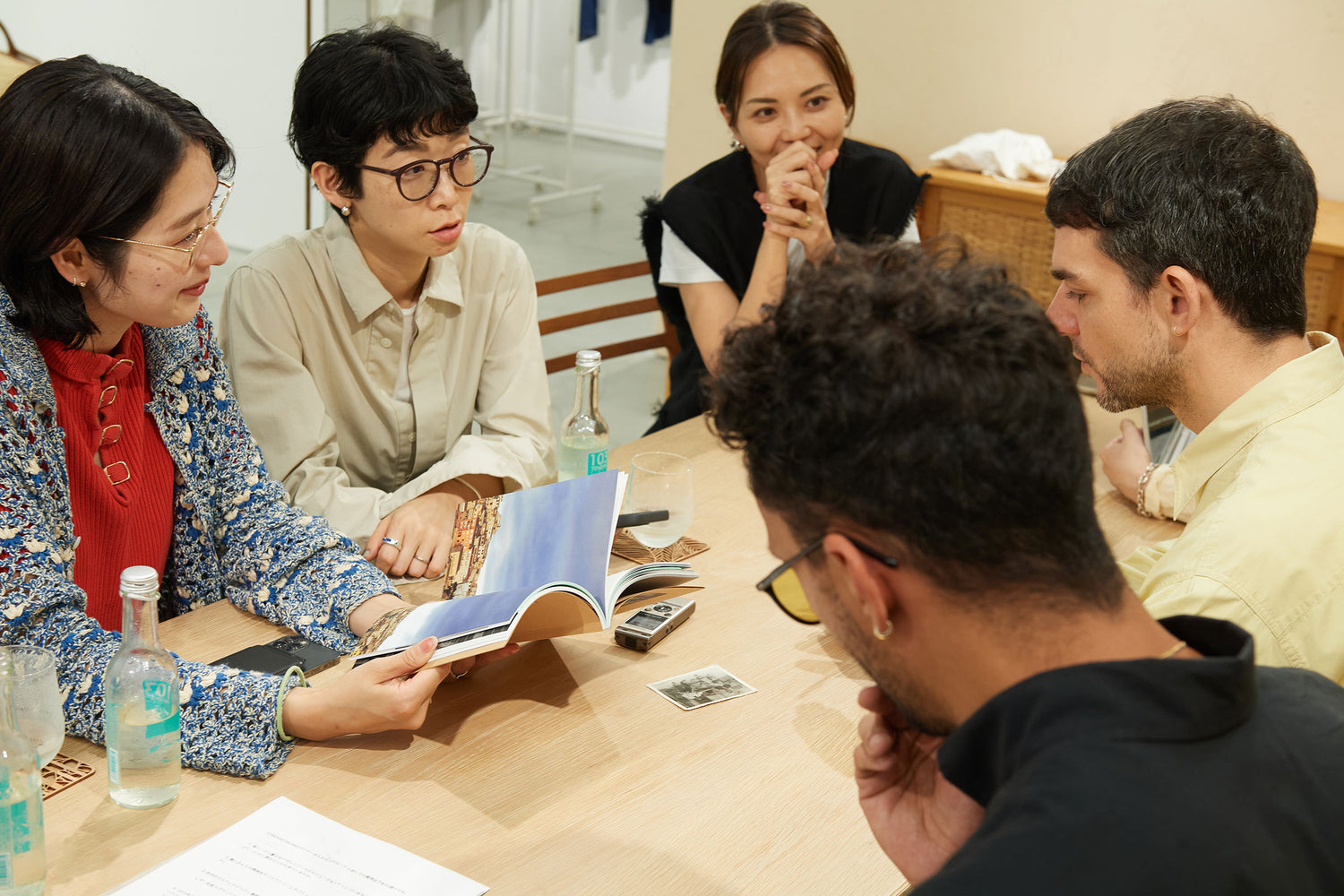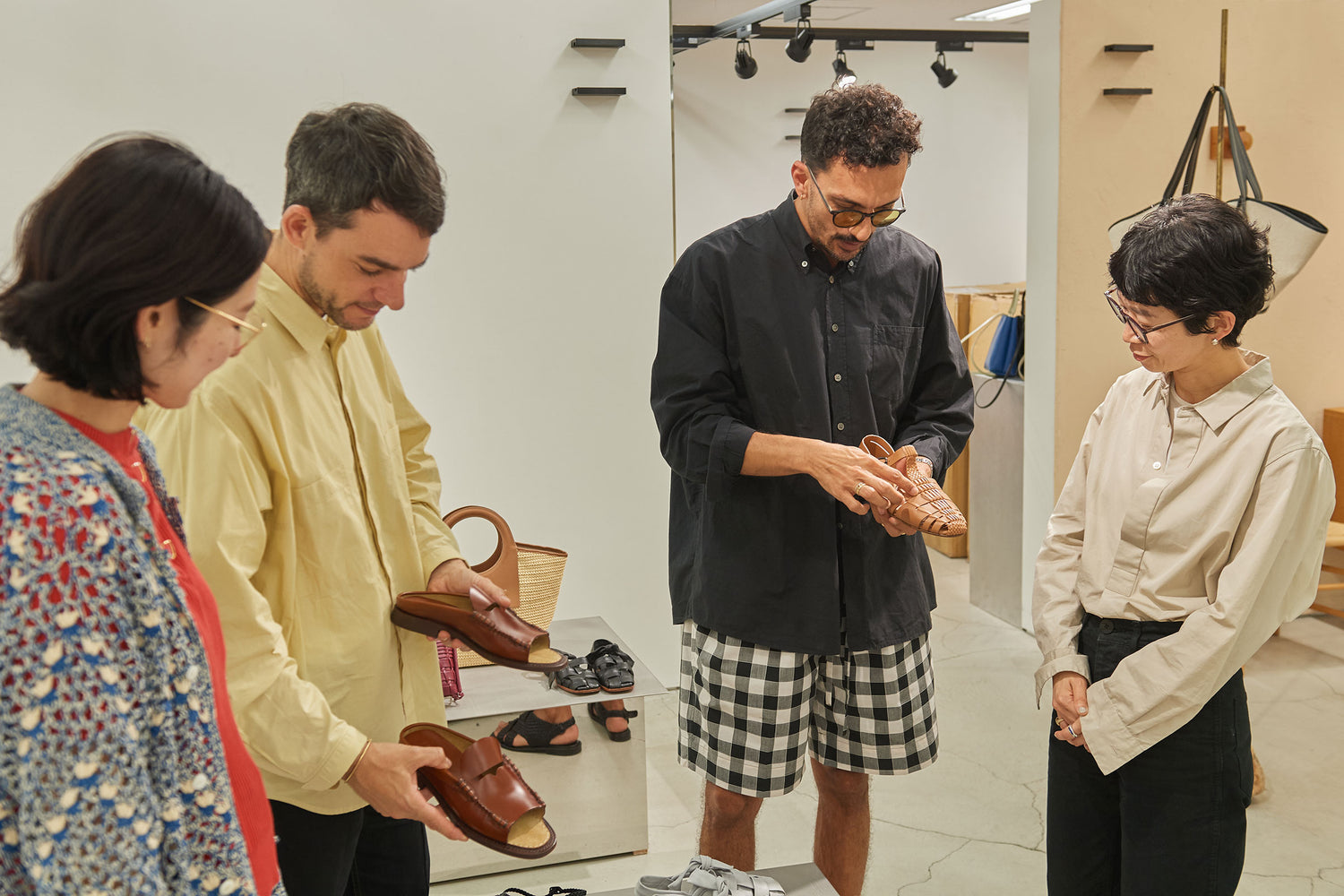Following the roots with TOMORROWLAND
The appeal of HEREU's leather goods is the exquisite balance of traditional Spanish leather craftsmanship and an urban essence. Alberto Escribano and Jose Luis Bartolome, the design duo, visited Japan. They spoke about craftsmanship with the Tomorrowland buying team, who were among the first to feature HEREU in Japan after its debut.
The leather goods produced by HEREU are a perfect balance of traditional Spanish leather craftsmanship with an urban essence. Albert Escribano and José Luis Bartolomé, who work together in the design unit, visited Japan, where they spoke about craftsmanship with the Tomorrowland buyer team, who were among the first to pick up HEREU in Japan after its debut.

TOMORROWLAND (TOMORROWLAND team, hereinafter T): HEREU's shoes and bags cannot be discussed without mentioning Spanish craftsmanship, but how did you two build that relationship?
HEREU shoes and bags would not be complete without Spanish craftsmanship, how did you two develop this relationship?
HEREU (HEREU team, hereafter H): Our approach to design is not like the traditional approach of coming up with a design first and then deciding who will make it. We value the craftsmanship first and then how to incorporate that into modern design. In Spain, there are many craftsmen and workshops with amazing techniques that have been passed down through the generations. Our relationship with those people is not like that of a manufacturer and a factory, but rather we consider everyone to be part of a team.
Our approach to design is not the traditional process of first devising a design and then deciding who will make it. First there is the craftsmanship, and then it's important to see how that can be incorporated into the design in a modern way.
There are many artisans in Spain, with workshops with excellent skills that have been handed down from generation to generation in the family. We think of our relationship with them as everyone being part of a team, rather than a manufacturer and a factory.
How did you discover these techniques and workshops?
How did you find such techniques and workshops?
When we first launched the brand, we started by flipping through the phone book and making calls. Since it was a small industry, we started to expand through introductions from people or friends of friends. Through these experiences, we started to think first and foremost about how to utilize the skills of our craftsmen.
When we first launched our brand, we really started by flipping through the phone book and making a phone call.
Eventually, because it's a small industry, it spread - someone introduced me to someone else, or a friend knew someone who knew someone else. This has led us to think first and foremost about how to utilize the skills that our craftspeople have.

You both started HEREU after working as designers in fashion capitals such as Paris and London. What sparked your interest in the craftsmanship of your hometown?
You both started HEREU after careers as designers in fashion centers such as Paris and London. How did you become interested in craftsmanship in your hometown?
HOf course, we loved the things around us from childhood. When we left our hometowns and went to the city to work in the fashion industry, we realized that in fact, we were surrounded by highly skilled craftsmen and beautiful things in our hometown. Spain is not a country that is good at marketing such things, so the current situation is that they remain simply traditional crafts. We realized that we were not properly discovering their value, and we wondered if there was something we could do.
Since childhood, we have of course liked what we see around them. When we left our hometowns and went to the cities to work in the fashion industry, we realized that we were actually surrounded by highly skilled craftsmen and beautiful things in our hometowns. But Spain is not a country that is good at marketing such things well, so it remains just a traditional craft. We realized that we weren't seeing the value of it properly, and came up with the idea that we could do something about it.
What is the source of inspiration for the T design?
What are the sources of inspiration for the design?
One thing we want is for our products to be usable beyond the H season. And also, it's always something that is related to our roots. We are from Mallorca and Valencia, which is on the opposite coast, respectively, and we both grew up in places with a lot of nature, both the sea and the mountains. Our unchanging sources of inspiration are the landscapes of our childhood, the things our parents had, and the things we found in their closets.
One thing we want is that it should be something that can be used across seasons. That and always being involved in our own roots. José Luis Bartolomé is from Valencia. Albert comes from Majorca. But we both grew up in a place with a lot of nature, both sea and mountains. The constant source of inspiration is the landscape of the fields when I was a child, or things like my parents had, or things I found in their wardrobes.
Is there an item that best embodies the mood of the T brand?
Are there any items that best embody the mood of the brand?
Especially for the Spring/Summer 2024 collection , which is being developed, we express the wildness and beauty of nature through raffia material. The bags are made of very thick cotton fabric, and the shoes have a woven leather effect. We also explored a design that would be comfortable to use, expressing real baskets that you would find in any home in the Spanish countryside using leather.
The roughness and beauty of nature are expressed through the raffia material, especially in the spring/summer 2024 season, which you can see in stores/our official online. For bags, it could be a very thick cotton fabric, and for shoes, it could be a woven leather effect. We sought a design that would be comfortable to use, using leather to represent the real baskets that are used in every house in the Spanish countryside.

While HEREU values the craftsmanship of its hometown, it also has a strong awareness of sustainability.
We know that as well as valuing the craftsmanship of their homeland, HEREU also has a strong commitment to sustainability.
We think it is so natural that we don't even think about using it as a marketing tool. If we pursue the quality of Spanish manufacturing and materials, we naturally end up sourcing raw materials primarily within Spain .
We take it for granted now to the extent that as a company we don't bother to mention it as a marketing tool against that point. As we pursued the quality of Spanish craftsmanship and materials, we naturally decided to source our raw materials in Spain.

Regarding T -materials, have you ever been involved in their development?
Are you sometimes involved in development with regard to materials?
Rather than developing new materials, we are always looking for something better. There is a place in northern Spain that produces very high-quality beef, and the leather that is often used in our collection is a by-product of that. It is thick and hard, so the process of making shoes from it is difficult, but it is a good leather that fits the foot very well. In addition to searching for good materials from various production areas, we are also particular about the raffia that we are using this spring and summer. The appearance of the design of raffia changes depending on how it is woven. By using traditional methods, the size is also fixed, but I feel a sense of accomplishment in designing in a way that makes use of that.
Rather than developing materials, we are always looking for better ones. There is a very high quality beef region in Northern Spain, and the leather that is often used in our collections comes from a by-product of that. The leather is thick and hard, so the process of making it into shoes is difficult, but it is a good leather that feels very comfortable on the foot. As well as searching for the best materials from various sources, we are also particular about the raffia we are using this spring/summer. The design looks different depending on how the raffia is woven. Using traditional methods sometimes limits the sizes of the bag , but I find it rewarding to design something that makes the most of this.
What kind of things are created when you combine the sensibilities you learned in the fashion industry with craftsmanship?
What generates when you two combine your craftsmanship with the sensibilities you have learnedt in the field of fashion?
H Rather than being conscious of fashion trends, we are interested in architecture and art, and I think we share a common aesthetic sense that is also found in fashion. By adding the things and techniques that my grandfather had, I want the shoes to be something that we would want to wear ourselves.
Rather than being conscious of fashion trends, we are more interested in architecture and art, and I think we share the same aesthetic sense that goes with fashion. We want it to be something we want to wear, by adding things our grandfathers had and skills.
You two look best in T HEREU shoes!
HEREU shoes look best on you both!
HI'm glad to hear you say that.
We are glad to hear you say so.
From the right, GALERIE VIE buyer Saori Kageyama, HEREU designer Jose Luis Bartolome, Alberto Escribano, SUPER A MARKET, LAND OF TOMORROW, and CABaN buyer Yu Takahashi
Your aesthetic sense can be felt throughout the brand, but what kind of developments do you have in mind for the future?
The HEREU brand is aesthetically pleasing to both of you in every corner, what are your plans for the future?
Rather than trying to make the H brand bigger, I want to think of ways to make use of our craftsmanship. I would like to release a photo book and propose a pop-up store that also sells homeware and other items.
Rather than trying to make the brand bigger, we like to think of ways to make the most of our craftsmanship. We would like to publish a photo book and propose pop-ups of homeware and other products to go with ours.
That 's something to look forward to.
That's something I'm looking forward to.
What is it about HEREU items that appeals to you two?
What do you both find attractive about HEREU items?
T (Takahashi): It's classic, but it's also playful. It looks neutral, but it's also a little humorous and unique. It's also loved because it's easy to wear and comfortable for women's everyday scenes.
(Mrs. Takahashi) Classic style though, playful as well. It looks neutral, but it is also unique, with a bit of humour. Women love them because they are easy to wear and comfortable for everyday situations.
T (Kageyama): As mentioned earlier, I like the creations that are full of local Spanish craftsmanship. It seems to respect tradition and technology, and reconstruct them by incorporating the atmosphere of the modern era. There is no strong logo or design, but the craftsmanship is wonderful and somehow HEREU-like. I also like that it is something you can use for a long time without getting tired of it.
(Mrs. Kageyama) As mentioned earlier, I like Spanish creations with local craftsmanship. It seems to me that the traditions and techniques are respected and then reconstructed to incorporate the atmosphere of the current era. There is no strong logo or design, but we also feel that there is a wonderful sense of manufacturing that is somewhat HEREU-like. I like the design that I never get tired of it and can use it for a long time.
H: What kind of customers do you like at TOMORROWLAND?
What kind of customers like HEREU at TOMORROWLAND?
Rather than people with a specific style, I get the impression that our products are purchased by people who enjoy a wide variety of fashion styles.
The impression is that customers who enjoy a wide variety of fashionable styles rather than a particular style are buying.
H TOMORROWLAND is a company that has been buying for us since we just launched our brand in 2014. In fact, it was Japan that recognized and saw the value in what we were trying to do sooner than Europe. I am truly grateful for the long relationship we have had.
TOMORROWLAND is a company that has been buying for HEREU since 2014, when we had just launched our brand.
In fact, it was Japan that was quicker than Europe to recognize what we were trying to do and see the value in it.
We are grateful for the opportunity to have a really long relationship with you.
Thank you for today .
Thank you for your time today.
Thank you H !
Thank you very much!
Text & Editing: Michino Ogura





